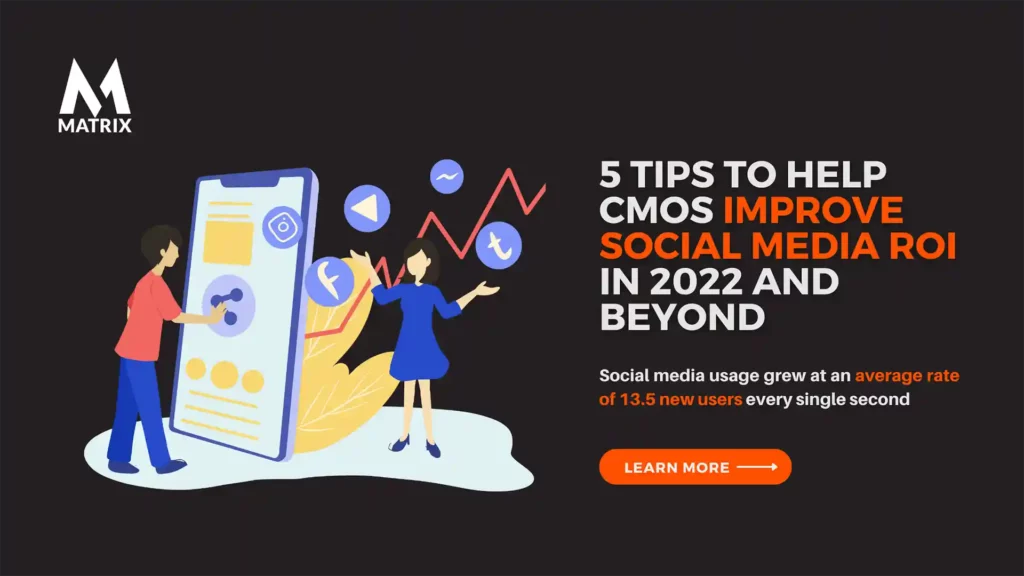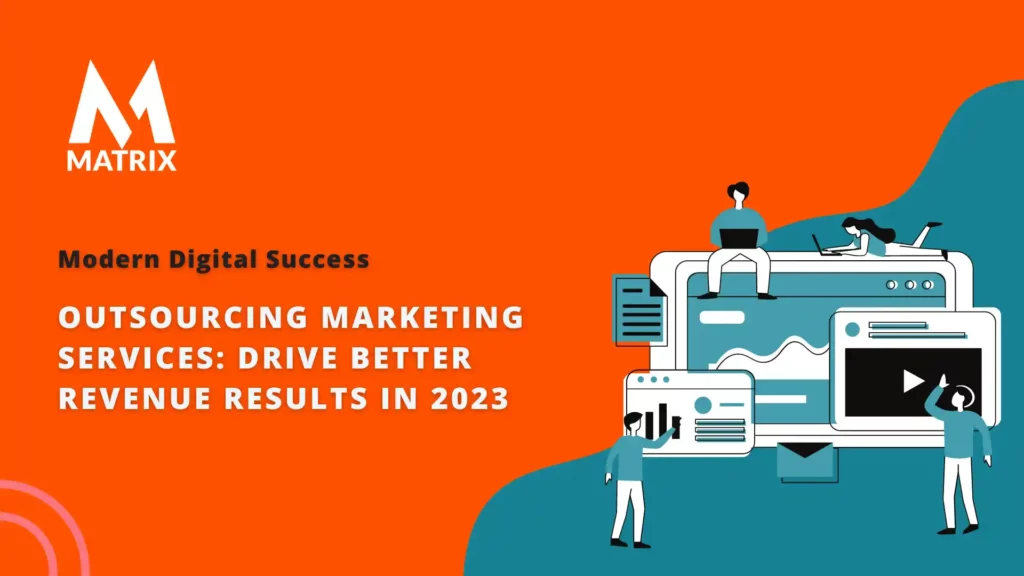5 Tips to Help CMOs Improve Social Media ROI in 2023 and Beyond
Learn how to use the 5 tips to help CMOs improve social media ROI in 2023 and beyond.
Brands are spending more and more on social media marketing every year.
In fact, according to data from Oberlo, social media ad spending in 2022 is expected to reach $63 billion (Statista’s predictions are even more impressive, with projected spending of more than $80 billion), an 11.15% increase from 2021. And, over the next few years, social budgets are only expected to increase.
But if marketers allocate almost 15% of their total marketing budgets to social media marketing, it’s only natural that they want to see next-level returns on the investment.
So, if you’re looking for tips on improving social media ROI in 2022 and beyond, this is everything you need to know about getting the biggest bang for your buck.
Calculating Social Media Marketing ROI
The main trouble with improving social media ROI is the simple fact that calculating the returns on an investment such as advertising can be tricky — especially for non-ecommerce businesses.
Sure, there is a formula that will help you estimate ROI:
ROI = (Sales Growth – Marketing Cost) / Marketing Cost
But, the problem is that most social media marketing campaigns aren’t designed around generating sales.
The primary goals for investing in social media include:
- raising brand awareness
- boosting engagement
- generating leads
- improving customer satisfaction and retention
And while these objectives contribute to (measurable) business success, assigning an exact monetary value to them is next to impossible.
So, before you start thinking about ways to improve social media ROI, you will first need to determine the relevant metrics. You will use these metrics to gauge whether what you’re doing on social is paying off.
6 Relevant Social Media Metrics to Calculate ROI
Reach vs. Impressions:
One of the easiest ways to measure whether your social media marketing strategy works is to look at the statistics surrounding your reach and impressions.
Now, while they may appear to show the same thing, you must understand the difference between them:
- Reach denotes the number of people who have seen your content.
- The number of impressions shows how often your content was displayed (sometimes multiple times to the same person).
To maximize your social media ROI, you must pay attention to both metrics.
The bigger your reach, the greater your brand awareness will be. However, impressions are equally crucial, as they measure your target audience’s interest in the content you distribute.
But even though they are crucial for getting started with gauging your social media ROI, reach, and impressions won’t give you the answers you seek. At least not without additional information.
Engagement Rate
The second elementary social media metric you need to follow is your engagement rate.
As it communicates how much your target audience interacts with the content you distribute, your engagement rate can signal whether your strategy is working out.
In 2022, engagement rate benchmarks are as follows:
Naturally, the digits vary across industries. However, having these numbers in mind can help you determine whether your audience is invested in the content you post or if you need to work on improving your strategy.
Audience Growth Rate
Your audience growth rate is another sign that your social media marketing efforts are working. The higher the number, the better.
Note that the more followers you have, the lower your growth rate. That’s why it’s a good idea to compare your audience growth rate to that of your competitors. That way, you can rest assured that your following is increasing at a competitive pace and that your social media strategy genuinely benefits your business.
CTR
If you’re using social media as a content distribution and traffic generation platform, the best way to measure success is to measure click-through rates.
A high CTR (the average in 2022 is just slightly above 1%) will show that your content is doing a good job of grabbing your audience’s attention. Moreover, it will prove that it’s fully optimized to awaken their interest. And, it will show that the people following you want to know more about your products/services/topics you cover.
Conversion Rate
If you sell via social media, the best metric to calculate your ROI will be to look at conversion rates.
For ecommerce, the median conversion rate in 2021 was 5.2%. However, note that traffic from social media channels had a higher chance of leading to a sale, with an impressive 7.6% conversion rate.
So, if you’re an ecommerce CMO looking to get the most out of your marketing spend, focusing on social media should be at the top of your priorities.
Cost per Click & Cost per Thousand Impressions
Finally, you have to accept that you will, at some point, have to spend money on social media channels.
In these cases, your most important metrics will be the cost per click and cost per thousand impressions.
Something as elementary as tracking the amount of money you’re spending on social media marketing and comparing it to the increase in revenue will inform you about the success of your strategy. And, it will give you a super-easy way to measure ROI.
Tips to Improve Social Media ROI
Now that you know what metrics to track to calculate your social media marketing ROI, it’s time to explore the tips that will allow you to get more value out of your hard work.
Tip #1: Set Your Budget and Stick with It
Sure, it would be easy (and convenient) to say that all CMOs need to secure a minimum sum to spend on social media marketing. However, the truth is that most brands have different business structures. And that means that determining marketing budgets is a highly individual process that depends on multiple factors.
Nonetheless, some research indicates how much a business should allocate to marketing.
Want Better Social Media ROI?
When was your last social media audit?
According to a 2022 survey conducted by Gartner, businesses are allocating, on average, 9.5% of their total revenue to marketing. Of that 9.5%, 11.3% is spent on social media (not including paid ads).
Of course, in the real world, simply setting aside a fixed amount of money to spend on a marketing channel won’t drive results. So, to make the most of your social media marketing budget, you will have to commit to actively managing your spending by:
- Reviewing your spending every quarter
- Measuring ROI on all social media investments
- Make your social media marketing approach flexible, adaptable, and scalable because consumer behavior is rapidly changing.
If you know you’re working with tight funds, look for budget-friendly social media strategies to help you establish a strong online presence without investing in all-new content.
For inspiration, you can look to Massimo Dutti. This brand regularly updates its Pinterest boards with new images from its ecommerce store, knowing full well that its target audience is likely to be using the platform for shopping inspiration.
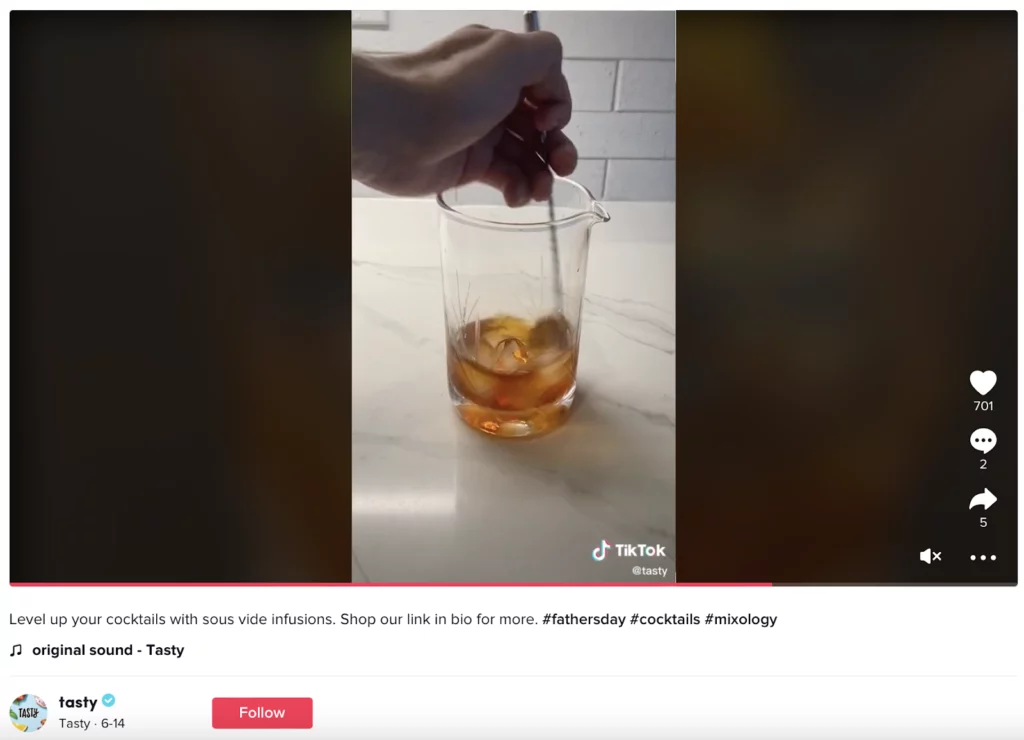
Similarly, Hada Labo Tokyo pulls images and product descriptions directly from its website and posts them on Instagram. It’s an ultra-budget-friendly strategy that requires zero spending. Yet, it works well, seeing that highlighting the benefits of products (along with some tips on how to get the most out of them) is what the cosmetics brand’s audience wants to see in the first place.
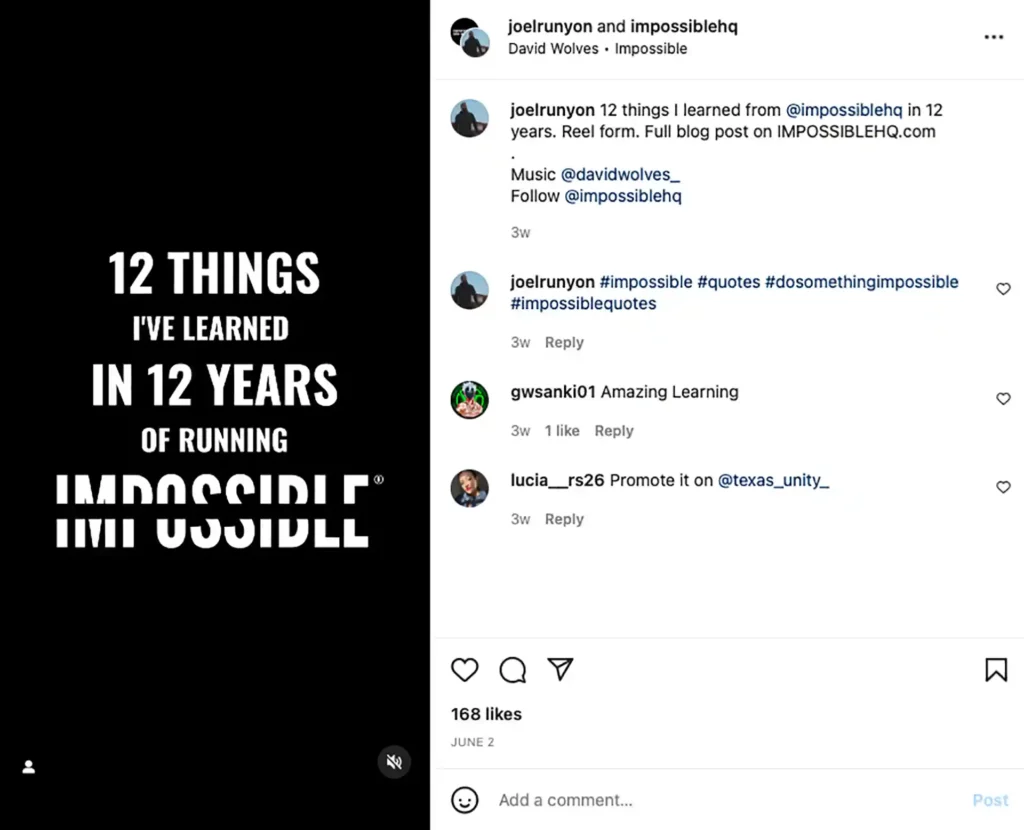
Source: instagram.com
And finally, check out how Impossible repurposes its blog content on Instagram, turning full-blown articles into bite-sized pieces of content that inspire and educate its audience.
Tip #2: Focus Your Efforts on Channels That Matter
Another impactful thing you can do to get a higher ROI from social media is to stop spreading yourself thin.
According to the 2022 HubSpot State of Marketing report, the most popular social media channels for brands include:
- YouTube
But here’s the thing. If you’re a B2B brand trying to reach professional clients, Instagram probably won’t be the best place for that. The same goes for trying to engage people under 30 and not being on TikTok.
Of course, demographic data about social media platform users shouldn’t give you a free pass for completely ignoring rapidly expanding channels. On the contrary.
If you see an opportunity to reach an audience segment you haven’t been able to reach for a while, go for it. Try new channels, experiment with your content formats, and see how you fare.
Who knows, you might end up with a super-effective new distribution platform that helps you get your product in front of thousands of new people. Just look at how SomniFix took a calculated risk by joining TikTok. The decision was right when aiming for a higher social media marketing ROI.
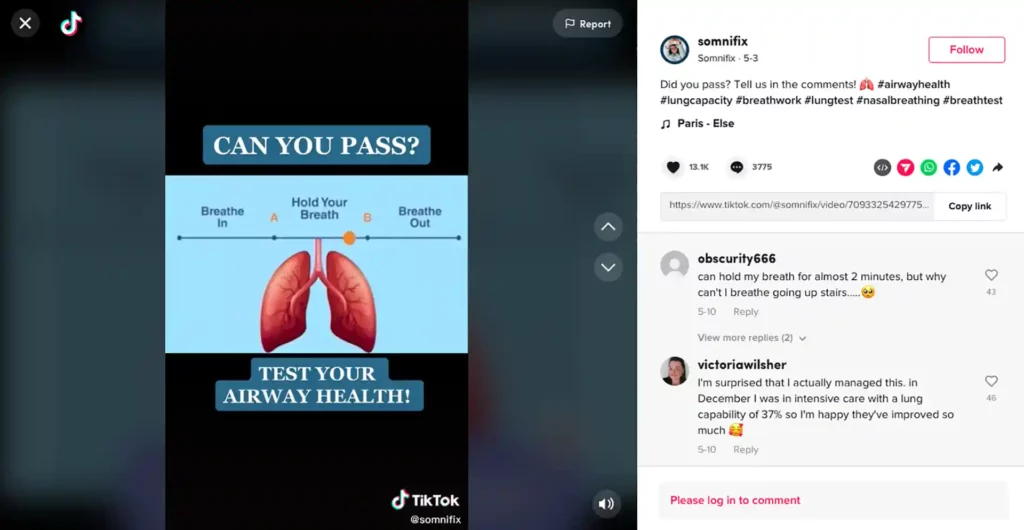
Source: tiktok.com
Tip #3: Perfect Your Audience Targeting
Defining your buyer personas represents one of the first steps of developing a business plan. But, if you’re after an impressive social media marketing ROI, it’s not a bad idea to go back to basics. Even if just for a moment.
For your social media content to resonate with your audience, you have to know whom you’re trying to reach, engage, and convert into a customer. And something as simple as a reminder of who your core audience is will ensure that the hard work you put into producing social media content results in conversions.
Moreover, a well-defined target audience will help you identify new opportunities for expanding your reach.
For example, you might find that the best way to reach new people is to use features such as Facebook’s lookalike audiences. Or, you might use results from your social media analytics to inform your SEM campaigns.
Tip #4: Keep Up to Date Regarding What Type of Content Works in 2022
People are spending an increasing amount of time-consuming content online. However, this doesn’t mean that marketers can publish anything just to do so and expect a good ROI.
On the contrary, research shows that people are becoming increasingly picky about the content they consume. This signals that the key to social media marketing success in 2022 is knowing what content types appeal to your target audience.
Consider the following three trends when working on your social media marketing strategy.
- Great Content Must Resonate with Its Intended Audience
HubSpot’s 2022 Social Media Marketing report identifies the funny, interactive, value-based, relatable, and educational social media content as having the biggest ROI.
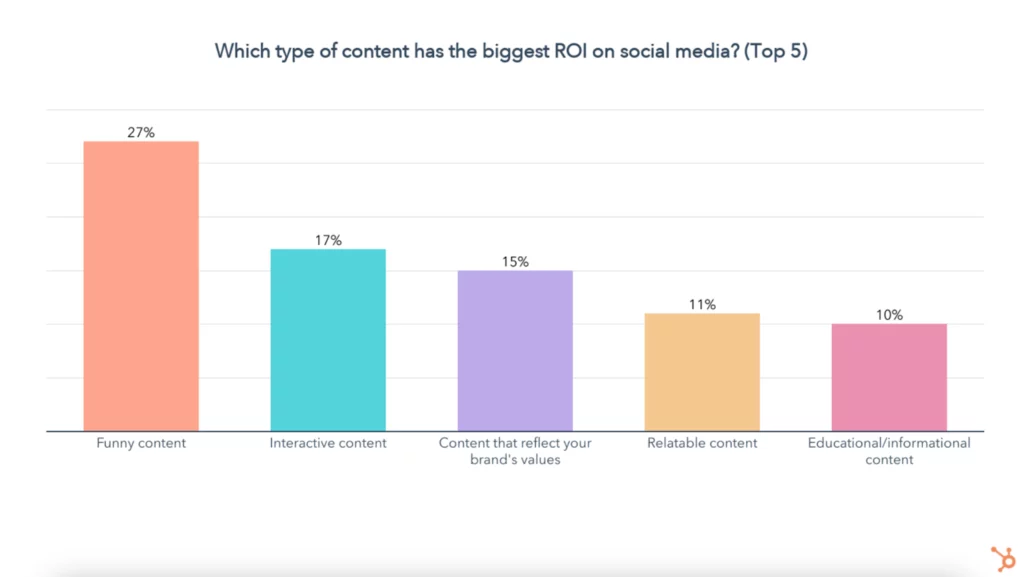
So, if you want to supercharge your marketing campaigns on the different social channels your brand uses, ensure that you’re investing in quality and value — not just quantity.
(Note that posting frequency also contributes to social media marketing success. However, research shows that too much self-promotion will drive as many as 81% of social media users to unfollow brands and influencers).
For a better alternative to chewing your followers’ ears off with monotonous posts about your products, you could look up to brands like KURU Footwear, which strives to educate its followers with social media posts.
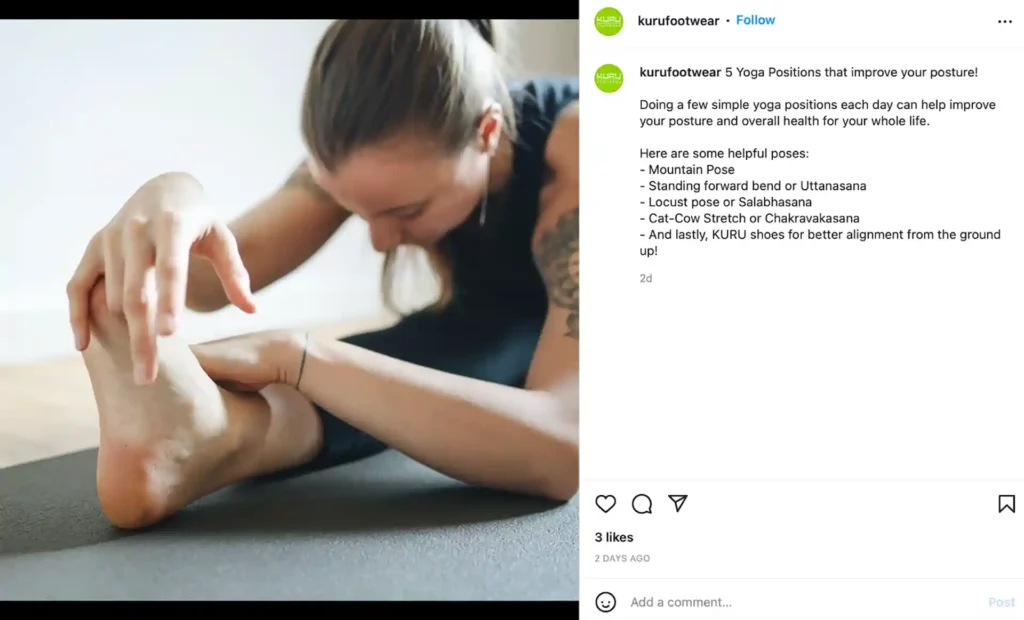
Or, even better, take inspiration from brands such as Ben & Jerry’s, which use social media to connect with people who share their values and employ their channels to give a voice to those who have none. Now, if this approach doesn’t engage consumers and encourage them to become supporters and advocates, nothing else will.

Short-Form Video Is the High-ROI Format to Invest In
In 2022, short-form video is the most successful format for reaching, engaging, and converting audiences.
Short-form video is a snackable format that appeals to today’s consumers. But, much more importantly:
- It lends itself to different social media channels.
- It’s the perfect vessel for presenting your audience with genuine value.
- Using it shows your potential customers how well you understand their pain points.
- Employing short-form video proves that you value your audience’s time and are ready to produce content they’ll enjoy without forcing them to waste precious minutes or even hours.
For a great example of a brand that’s fully embraced the format, check out Tasty’s TikTok content. It’s entertaining, educational, and successful with the brand’s audience, all the while proving that real value doesn’t exclusively come in the shape of long-form blog posts or 20-minute YouTube videos.

Don’t Underestimate the Power of Earned Media and UGC
Finally, don’t forget that diversity is now non-negotiable.
In fact, TINT’s latest State of User Generated Content report found that 65% of people think it’s essential for brands to channel diversity by employing UGC.
So, if you’re looking for exceptional results from your social campaigns, consider giving your loyal customers a voice.
GILI does it splendidly, seeing how the majority of its Instagram posts consist of customer spotlights and breathtaking shots submitted by the brand’s happy clients.
The approach isn’t just a genius way of combining social media marketing with social proof. It’s also an excellent method for building a tight-knit community. And that, in turn, inevitably leads to greater customer loyalty levels and a higher CLV down the road for the ecommerce brand.
img
Source: instagram.com
Tip #5: Don’t Stop at Raising Awareness If You Want the Biggest ROI
Last but not least, don’t forget that there are many ways in which your business can benefit from having a strong social presence.
Yes, reach is one of those benefits. However, you can also use social media for other formats of success. You can utilize it to:
- Boost your customers’ investment in your brand
- Build relationships with followers
- Employ social listening and use the data to improve your products and services and identify market gaps your business can target
- Generate organic traffic for your website or business blog (for example, check out how Earth.fm does that via Twitter)
Improving Social Media ROI in 2023 and Beyond
Whether your brand’s social presence is big or small, you are most definitely looking for a high ROI. The five tips described in this article are all guaranteed to ensure your hard work pays off.
However, you must continually update your strategy to truly maximize your brand’s social media marketing attempts. Implement the tips from this guide, keep up with consumer trends, and measure your social media success based on the KPIs we’ve listed above.
That way, you can rest assured that you’re getting the biggest bang for your buck when investing in social media. Plus, you will know, for sure, what it will take to remain relevant in a world where consumer behavior changes month after month.
Since social media can be a complex and ever-changing landscape, it’s important to stay up-to-date on the latest trends and changes to get the most out of your investment. Sift through all the social media ROI tools.
To help you out, we’ve compiled a list of some of the best resources for staying ahead of the curve:
- Social Media Examiner – This blog is dedicated entirely to social media. They publish daily articles covering everything from new features on various platforms to case studies and tips for getting more out of your social media strategy.
- HubSpot’s Social Media Resource Center – This extensive collection of articles, ebooks, and other resources covers everything from getting started with social media to using advanced features on various platforms.
- Sprout Social Insights – This blog covers a wide range of topics related to social media, including content strategy, platform tips, and more.
- Socialbakers Blog – This blog covers a wide range of topics related to social media, including content strategy, platform tips, and more.
- Hootsuite Insights – This blog covers a wide range of topics related to social media, including content strategy, platform tips, and more.
- Buffer Blog – This blog covers a wide range of topics related to social media, including content strategy, platform tips, and more.
- CoSchedule Headline Analyzer – This tool helps you write headlines that are more likely to get clicked on social media.
- BuzzSumo – This tool lets you see the most popular content across all social media platforms.
- Quora – This is a great place to find answers to any questions about social media.
- Twitter Lists are curated lists of users that tweet about specific topics. You can use them to find new people to follow and get more insights into your industry.
When it comes to social media, there is no one-size-fits-all approach. However, following the tips in this article, you can create a strategy tailored to your business and its goals. With a little trial and error, you can find what works best for you and start seeing an ROI from your social media investment.
Let us know if you need a social media ROI calculator. The social media ROI definition is simple. Make more than you spend. You should know how to calculate social media ROI. Do you?
FAQs
The Operations Hub can help you improve your social media ROI in a few ways. It provides a single platform where you can manage all of your customer interactions. This makes tracking and responding to customer feedback easier and helps you ensure no issue goes unresolved.
There are a few key things to keep in mind when trying to improve your social media ROI. First, make sure that you are tracking the right metrics. Don’t focus on vanity metrics like likes and followers; instead, track engagement rates, conversion rates, and other relevant data to your business. Second, ensure your social media content is high quality and aligned with your brand. Third, experiment with different types of content and strategies to find what works best for you. And finally, always be prepared to adjust your strategy based on the data you’re collecting.
You already know how important social media is to increase brand awareness, generate more leads, and ultimately score more conversions.
The world is on social media — 50% of it, at least — so if your product, service, and mission reach the maximum number of people, your business needs to be on social media, too.
However, social media can be extremely time-consuming.
There is no one-size-fits-all answer to this question, as the ROI from social media will vary depending on your business and its goals. However, you can do a few things to measure the ROI from social media. First, track the engagement rates for your social media posts. This will give you a sense of how well your content resonates with your audience.
Let’s Connect
Quisque aliquam nisl quis metus taylor feugiat. Lorem ipsum dolor sit amet, consectetur adipiscing vestibulum vitae gravida non diam accumsan.

